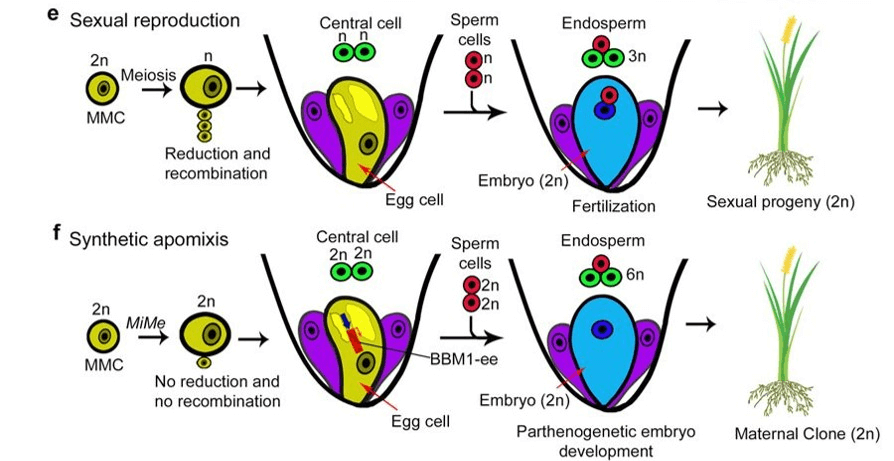Apomixis DefinitionApomixis is a fascinating phenomenon in the world of plant biology that allows for the production of seeds without fertilization, resulting in offspring that are genetically identical to the parent. This unique form of asexual reproduction has intrigued scientists and plant breeders for decades due to its potential applications in agriculture and crop improvement. 
In this article, we will explore the definition and history of apomixis, the different types and mechanisms involved, the advantages and disadvantages of apomixis in plant reproduction, and its importance in agriculture and biotechnology. We will also examine the challenges and limitations of studying and exploiting apomixis, as well as its potential impact on food safety and sustainability. Defining the ApomixisApomixis is a form of asexual reproduction in plants that results in the production of seeds without fertilization. In this process, the embryos are formed from somatic cells of the ovule, bypassing meiosis and the formation of gametes. This results in offspring that are genetically identical to the parent plant. Apomixis can occur through several mechanisms, including adventitious embryony, gametophytic apomixis, and diplospory. Apomixis has many potential advantages in plant reproduction, including the ability to bypass the costs and uncertainties of sexual reproduction, such as the production of sterile offspring or the need for compatible mating partners. Apomixis has significant implications in agriculture and biotechnology, as it can be used to propagate superior crop varieties without losing their desirable traits. Additionally, apomixis has potential applications in horticulture, forestry, and biotechnology. HistoryThe history of apomixis dates back to the early 1800s when the concept of asexual reproduction in plants was first proposed by German botanist, Franz Unger. However, it was not until the 20th century that the phenomenon of apomixis was scientifically described and classified. One of the earliest discoveries of apomixis was made in 1906 by the Russian botanist Sergei Navashin, who observed the formation of embryo sacs from somatic cells in certain plants. This type of apomixis, particularly known as diplospory, became the focus of much research in the following decades, leading to the discovery of other forms of apomixis, such as gametophytic apomixis and adventitious embryony. The study of apomixis has also been influenced by advances in genetics and molecular biology. In the 1980s, researchers began to identify genes and genetic markers associated with apomixis, which provided new insights into the molecular mechanisms underlying the process. Today, apomixis continues to be a topic of research and interest in the fields of plant biology, agriculture, and biotechnology. The potential applications of apomixis in crop improvement and genetic engineering have led to increased efforts to understand the genetic and molecular basis of the associated phenomenon. Types of ApomixisThere are several types of apomixis, each with different mechanisms and characteristics. The three most common types of apomixis are: DiplosporyIn diplospory, the embryo sac is formed from a somatic cell in the ovule, rather than through meiosis. The resulting embryo is genetically identical to the parent plant. This type of apomixis is found in a variety of plant families, including grasses, legumes, and composites. AposporyApospory involves the formation of an embryo sac from a non-reproductive cell, such as a nucellar cell. The resulting embryo is genetically identical to the parent plant. Apospory is found in a variety of plant families, including citrus, grasses, and ferns. Gametophytic ApomixisIn gametophytic apomixis, the embryo is formed from a cell within the female gametophyte, rather than from a fertilized egg cell. The resulting embryo is genetically identical to the parent plant. Gametophytic apomixis is found in a variety of plant families, including aster, dandelion, and carrot. There are also other types of apomixis, such as adventitious embryony, which involves the formation of embryos from cells in the ovule that are not part of the embryo sac. Adventitious embryony is found in a variety of plant families, including citrus, cacao, and rubber. Overall, the different types of apomixis reflect the diversity of mechanisms that plants use to reproduce asexually and bypass sexual reproduction. Mechanisms of Apomixis
The mechanisms of apomixis are the specific processes by which plants are able to produce embryos without sexual reproduction. There are several mechanisms of apomixis, each with its own unique characteristics. Adventitious embryony is a type of apomixis in which an embryo develops from a somatic cell, such as a leaf or stem cell, rather than from a cell within the ovule. This type of apomixis is relatively rare but has been observed in some citrus and mango varieties. Gametophytic apomixis, as previously mentioned, involves the development of an embryo from a cell within the female gametophyte, rather than from a fertilized egg cell. This type of apomixis is characterized by the development of a functional female gametophyte that is capable of producing embryos without fertilization. Gametophytic apomixis is common in a variety of plant families, including grasses, and has been studied extensively. Diplospory is another type of apomixis in which an embryo develops from a diploid cell within the ovule, rather than from a haploid cell that has undergone meiosis. This type of apomixis is relatively common in some plant families, including the Rosaceae family, which includes important crop species such as apples and strawberries. The specific mechanisms of apomixis can vary widely among plant species and families, and there is still much to be learned about the genetic and molecular processes that underlie these mechanisms. However, by understanding the different mechanisms of apomixis, plant breeders and biotechnologists can work to harness the potential of apomixis for crop improvement and the development of new plant varieties. Advantages and DisadvantagesApomixis has both advantages and disadvantages in plant reproduction. Let us discuss some noteworthy pros and cons: AdvantagesSome of the key advantages of apomixis include the following:
DisadvantagesThere are also some disadvantages associated with apomixis, including:
Apomixis has the potential to offer significant benefits in plant reproduction, but it is important to carefully consider both the advantages and disadvantages before implementing apomixis in a particular plant breeding program. Apomixis v/s Sexual ReproductionApomixis and sexual reproduction are two different modes of plant reproduction, with several key differences. Here are some of the main differences between apomixis and sexual reproduction considering various aspects: Genetic VariationSexual reproduction involves the fusion of male and female gametes, which leads to the creation of new genetic combinations in the offspring. In contrast, apomixis produces offspring that are genetically identical to the parent plant, resulting in very little genetic variation within the population. MechanismsSexual reproduction involves the formation of male and female gametes, which then fuse to form a zygote. In contrast, apomixis involves the formation of an embryo from a somatic cell, without the need for gamete fusion. ParentageIn sexual reproduction, offspring inherit genetic material from both male and female parents. In apomixis, offspring inherit genetic material only from the female parent. EfficiencyApomixis can be a more efficient mode of reproduction than sexual reproduction, as it allows for the production of large numbers of genetically identical offspring without the need for pollinators or fertilization. AdaptabilitySexual reproduction allows for greater adaptability to changing environmental conditions, as it creates new genetic combinations that may be better suited to new environments. Apomixis, on the other hand, produces genetically identical offspring that may be less adaptable to changing conditions. Apomixis and Sexual reproduction represent two distinct modes of plant reproduction, each with its own advantages and disadvantages. Depending on the goals of a plant breeding program, either apomixis or sexual reproduction may be preferred. Importance of ApomixisApomixis is an important process in plant reproduction, with several potential applications and benefits. Here are some of the main reasons why apomixis is important:
Apomixis is an important process in plant reproduction that has a wide range of potential applications and benefits. By allowing for the production of genetically identical offspring, apomixis offers an efficient and effective method for plant propagation, hybridization, and conservation. Examples of Plants that Exhibit ApomixisThere are many plant species that exhibit apomixis. Here are a few examples:
These are just a few examples of the many plant species that exhibit apomixis. Apomixis is a common process in the plant kingdom and can be found in a wide range of species, from ferns to flowering plants. Applications of ApomixisApomixis has several potential applications in agriculture and plant breeding. Some of these applications include:
Challenges and LimitationsThere are several challenges and limitations associated with apomixis in plant breeding, such as:
While apomixis offers several advantages, there are also significant challenges and limitations that must be addressed to fully exploit its potential in plant breeding. To overcome these challenges and fully realize the benefits of apomixis, continued research and development in this area is necessary. Future Prospects and Potential ImpactsApomixis has the potential to revolutionize agriculture and food safety in several ways. Here are some future prospects and potential impacts of apomixis:
Overall, apomixis has the potential to significantly impact agriculture and food safety, by improving crop breeding efficiency, expanding crop applications, enhancing genetic diversity, improving seed production, and increasing sustainability. Continued research and development in this area will be necessary to fully realize the potential of apomixis in agriculture in the near future. The Bottom LineIn conclusion, apomixis is an important and fascinating aspect of plant reproduction with significant potential applications in horticulture, forestry, and biotechnology. Despite its advantages, apomixis still faces challenges and limitations in terms of understanding its mechanisms, controlling its expression, and exploiting its potential in plant breeding. However, with advancements in molecular biology and genetic engineering, researchers and breeders are making progress towards harnessing the power of apomixis for crop improvement and food safety. The future of apomixis in agriculture is promising, and continued research in this field has the potential to revolutionize plant breeding and contribute to sustainable agriculture.
Next TopicApoptosis Definition
|
 For Videos Join Our Youtube Channel: Join Now
For Videos Join Our Youtube Channel: Join Now
Feedback
- Send your Feedback to [email protected]
Help Others, Please Share










